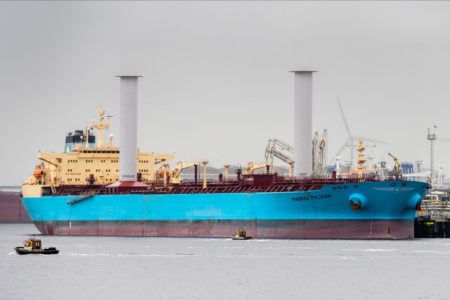October 29, 2019 – Maersk, the world’s biggest maritime shipping company, outfitted the Maersk Pelican in August of last year to test two cylindrical mechanical sails that use pressure differential to spin and propel a vessel forward. The Pelican, a crude oil tanker weighing over 67,000 tons, was outfitted with Norsepower Rotor Sails measuring 30 meters (98.4 feet) in height and 5 meters (16.4 feet) in width. and subjected to normal operations in conditions ranging from tropical to Arctic seas, and traveling from Europe to the Middle East, Asia, and Australia. The test began on September 1, 2018, ending on September 1, 2019. Having established baseline performance for the vessel the previous year without the rotor sails using full-scale digital measurements, after installation performance over the one year showed the vessel using 8.2% less fuel, an equivalent of producing 1,400 tons less of carbon dioxide (CO2).
Maersk along with other maritime shipping companies are seeking ways to reduce their carbon footprints. One way has involved reintroducing wind power into maritime transportation. Most of us, however, think of wind power and traditional canvas sails. Norsepower, however, has experimented with an alternative dredged up from the past, a failed 1926 invention, a rotating cylinder that uses its motion to create a push phenomenon similar to the wind hitting sails. In this case, however, the airstream created comes from backspin, just like a spinning baseball released by a pitcher creates lift changing the flight of the ball.
Norsepower, the builder of the rotor sails has installed them on three ships so far. In the Pelican project, they partnered with Maersk Tankers, Energy Technologies Institute (ETI), and Shell International Trading and Shipping Company. Independent oversight and performance analysis was carried out by Lloyd’s Register’s Ship Performance Group. The partners plan to publish detailed results of the one-year pilot project.
Tommy Thomassen, CTO of Maersk Tankers when interviewed described the positive outcome of the one-year test noting optimal usability, safety, and performance under all conditions the Pelican faced. The company is looking for ways to reduce overall greenhouse gas (GHG) emissions and Thomassen sees wind technology as a potential breakthrough. Maersk has set a fleet emission reduction target of 30% by 2021, and 60% reduction from a 2008 baseline by 2030. The plan is to continue operating the Pelican with rotor sails and install the technology on other ships in the fleet.
Shipping is responsible for between 2 and 3% of GHGs, and with 80% of global trade traveling by sea, the industry is working on getting to a state of carbon neutrality by 2050. Maersk wants to be zero-emission in its operations by that date. To get there the company is experimenting with new ship designs, carbon-neutral fuels, rechargeable, and continuous-charge electric propulsion systems, and, of course, wind power. Total investment to achieve carbon neutrality so far has amounted to $1 billion USD. The company has reached out to researchers, academics, technology inventors, investors, cargo owners, and governments seeking co-development and sponsorship of sustainable solutions that eliminate traditional fossil fuels from maritime shipping. The company describes climate change as “one of the most important issues in the world.”








